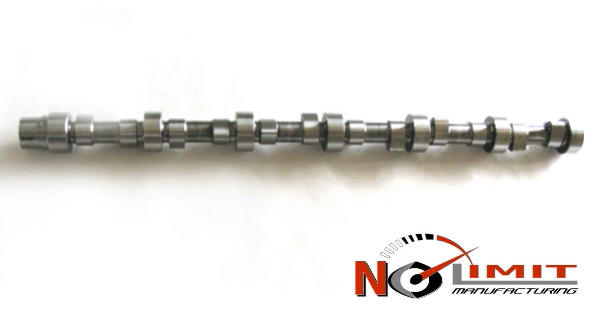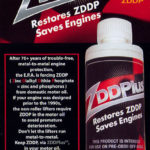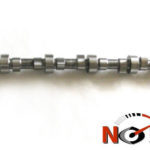Description
186-215 108.5 LSA .300/.315 Lift
Options:
Front Cam Bearing Stock: Camshaft is coated to allow for applications that will be using the OEM block with out adding additional camshaft bearings. This is an option for rebuilds and mild performance upgraded builds. Mostly limited to normal street use, and towing. If running the engine at higher rpms and heavy loads, then camshaft bearings are recommended.
7 Cam Bearings Throughout Block: This is recommended for high performance street and race applications. Higher spring pressures, and rpms cause the reduction of oil film between the camshaft and block. This can cause excessive wear on the block resulting in engine failure. To relieve this possibility it will be necessary to install cam bearings in all 7 journal locations in the block. When the camshaft is ordered with this option we polish the coating off the journals because the coating can damage the camshaft bearings.
If you have any questions or you don’t which option is best for you please call us and we will help you get the right camshaft.
Tow/Street Strip Cam
Our Cams Feature:
- Induction Hardened Steel Core Construction for strength that resist cracking under severe stress
- Large Radius on all corners
- Every cam is drilled and tapped for a bolt on retainer
Here are some of the benefits you will see with our cams. Results will vary depending on the grind you choose.
- More duration
- Lower EGT’s 100-250 degrees
- Faster spoolup 100-200rpm
- Bolt on gear option
- Major reduction in smoke
- Increased HP
Even better spooling than our 186/209 cam. This cam does not sacrifice torque efficiency . On trucks that are utilizing more fuel, you will see a reduction in smoke and EGT. Increased horse power this cam is great for the person that occasionally pulls or races their truck. This is one of my favorite camshaft profiles.
The term “Drop in Cam” is used very often in our industry. So I will define “Drop in Cam” . A drop in cam means you should not have to modify the standard unaltered OEM block or engine parts used in conjunction with our camshaft. This does not mean you can simply install the camshaft, align the timing marks, and you are safe. These camshafts are built to provided more performance, thus lessening the piston to valve clearance the engine has in the stock form. Keep in mind that some Cummins cam gears have slightly different offsets built in, and production tolerances of the gears, camshaft, block, and cylinder head also change the clearances of installed parts from engine to engine. Typically you should not need to add valve relief pockets in the pistons; however it is the customer’s responsibility and the customer must check and insure that installed center lines, and piston to valve clearance is appropriate for engine operating conditions. If you have had any block or head work done, or installed any aftermarket parts, (including an aftermarket camshaft) you must check piston to valve clearance, and camshaft timing to insure proper alignment before starting your engine.
Our camshafts work best when the intake lobe center line is installed from 98° to 103°. To modify installed center lines call us for offset keys, or an adjustable cam gear. A basic degree wheel, a small amount of wire and a dial indicator is all that is needed to degree a camshaft in.
Tappets – What you need to know before installing your camshaft.
This cam requires the use of a 1.300 diameter tappet or larger. You must have new tappets supplied by No Limit MFG for any applicable warranty. The No Limit Cummins 1.4 Dia. Nitrotech Tool Steel Flat Tappet Lifter PN CMN008007 is built to take high rpm, and higher than stock spring pressures found in today’s vehicles. We have many miles of testing on these lifters, and they provide a superior durability and wear over the stock lifters. They are also much stronger, and resistant to cracking. We have used these in street, modified street, drag racing, and pulling vehicles. These lifters work very well with steel camshaft cores, and cast camshaft cores. They will take pressures up to 450 + lb open spring pressure, in comparison to stock lifters that are only good to the 350 lb open spring pressure.
Features include:
- Tool Steel Body increases strength, and virtually eliminates mushrooming of base material.
- Crowned face promotes lifter rotation, and reduces lifter wear.
- Micro polished face reduces wear of the lifter face.
- Large Diameter Foot for high velocity, and acceleration lobe profiles.
- Proprietary heat treating process that creates a hardened and lubricated layer that significantly reduces wear. Similar wear characteristics to our DLC coated lifter tappets with out the possibility of a coating faking off.
Cylinder Head Springs
On engines seeing over 30 psi, over 500 hp, or over 3500 rpm we also suggest to please call, and we will help you determine the spring you will need.
Preparing your engine block:
A steel camshaft will stop most breakage due to harmonics, and twist, but it is still vulnerable to breakage from journal seizure. The Cummins engines, have either one or two bearings for the seven journals. The other five or six journals ride directly on the block. In instances where big lift cams and high spring pressure are used, the cam can push through the oil film that separates the cam and block and seize. Having the block line bored and installing journal bushings will ensure this does not happen with a cast or a steel camshaft. If you are running a cam with more than 210 degrees of duration @.050″, more than .340″ lobe lift, more than 375# nose pressure or getting close to 4500 rpm, it is highly recommended to have your block modified to accept cam journal bearings for all 7 journals. Even if you do not meet these specifications, and you are using it in any type of pulling or racing, it is highly recommended to have your block modified to accept cam journal bearings for all 7 journals. We even recommend having your block align bored and cam bushings installed on any engine for any use. If your block has been removed from the truck, or can be removed, it is a low cost insurance to have this done. Ask your dealer, or give us a call and we can help get you to a good machine shop to perform the work.
GOOD OIL IS IMPORTANT!!!
It first starts with the break in process. Do not use used oil. Used oil carries contaminants, and the additives that help lubrication under extreme pressure have been broken down, and are much less than new oil. So it is very important to start with new oil. There are many break in oils available. Use a break in oil that has a high zinc content. You can use a much higher zinc content than 1400 ppm. For break in you want a minimum of 2600 – 3000 ppm. If your oil is low in zinc also known as ZDDP, you can add a engine break in additive. Make sure you use an additive that has a high concentration of ZDDP.
Recommended Break in Oils and Additives:
- Driven Break in Oil
- Amsoil Break in Oil
- Lucas Break in Oil Additive.
- ZPLUS ZDDP Additive. CLICK HERE PURCHASE
Make sure to follow oil manufacturers instructions. Having to much is better than not enough during break in. Also coat the camshaft with a camshaft paste. Camshaft paste is available from Zplus, and No Limit MFG. The camshaft paste will stick to the camshaft and not slide off. It also has Moly, and ZDDP additives to help with extreme pressure lubrication during break in. All oil is not the same. Even synthetic oils are very different. Oils made today are made for new vehicles with emissions devices. Oil from the past, have additives that over a period of time, will plug and corrode the emissions devices on new vehicles. So the government has set new regulations for oil to reduce their effect on the emissions devices. The main additive that is removed is ZDDP. This additive was the most well known and the best at reducing wear of sliding metal components. The reduction of this additive has caused the automotive industry to have many wear problems early on in the new regulations life. Many of the problems have been related to flat tappet camshaft wear. To resolve the problem most OEM automotive car companies have converted to roller lifters , and camshafts to match. In the case of the flat tappet camshafts all camshaft manufactures only recommend using higher ZDDP concentrated oils used in the past. So what does this mean for new vehicles like the 6.7 Cummins. Well you will have to choose between lessening the time your vehicle’s emission s systems will last or run the risk of damaging your camshaft. We highly recommend using high ZDDP oils or zinc additives for low ZDDP oil. Your oil must contain at least 1800 - 2000 ppm of ZDDP. So KNOW Your Oil. Just because it is synthetic , or high tech, does not mean it contains enough ZDDP. If it does not, it will result in damage to the camshaft and lifter. Good oil is a low cost solution to longevity of engine parts.
Usually oil manufactures that produce racing oil have the oil you need. Make sure to tell them you need a ZDDP content of 1800 – 2000 ppm or more, and this is being used in a diesel truck or car. If your not sure give us a call and we will get you in the right direction for oil. (Note: most oils do not contain that high of ZDDP levels. In most instances you will need to add extra ZDDP to your oil.)
Also make sure they know your application. Racing oil is made for racing, and doesn’t have the detergent additives needed to drive your vehicle on the highway. And typically oil used in your vehicle for highway use doesn’t always offer the heat properties of racing oil. So if you are driving your vehicle on the highway and racing, pulling, or drag racing it, you will need to consider using two oils.
Typical race oil changes are 2 – 3 races down a pulling track or drag track. Remember you only have 2.5-3 gallons of oil in your engine. This is small compared to our high performance tractor engines that carry 6-8 gallons of oil. Also keep in mind that severe duty conditions also effect the change interval. If your towing, towing heavy loads, street racing, revving your engine, (rolling coal), or driving on hot days, these all effect how long the oil can protect the wear components of your engine. Typically change intervals will be greatly reduced in these conditions. A good way to determine your oil change interval is to have your oil tested. If your interested or would like your oil tested please call us.



